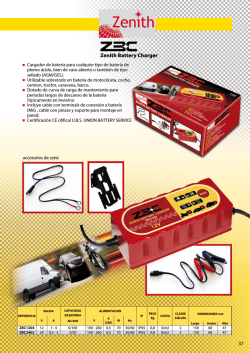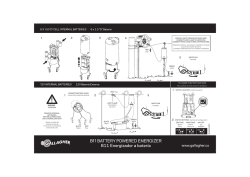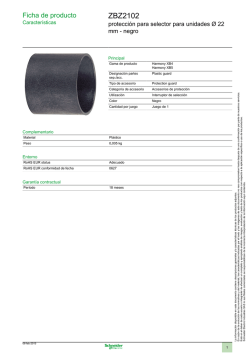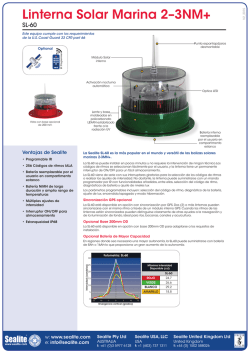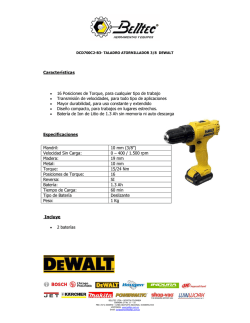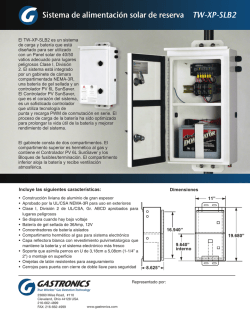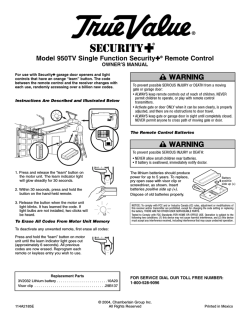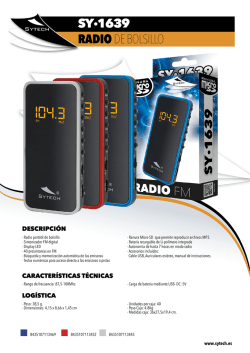
Manual - CIRCUTOR
Formato: 137mm x 190mm GU-1382 EXP220240 Megóhmetro de alta tensión Manual de uso P. 03 High voltage insulation tester User guide P. 23 MI-20KVe Megóhmetro de alta tensión Manual de uso GU-1382 3 ( Precauciones de Seguridad • Deberán leerse y comprenderse las Precauciones de Seguridad y el Manual de uso antes de usar el instrumento. • Respete rigurosamente las normas de seguridad para el trabajo con alta tensión cuando utilice este equipo. Las tensiones generadas son peligrosas. • Nunca conecte o desconecte las puntas de prueba con el megóhmetro en fun- cionamiento o mientras el indicador luminoso de Alta Tensión está encendido. Si tiene que hacer alguna modificación al conexionado hágala con el equipo apagado. • Jamás deje la punta de alta tensión, el terminal cocodrilo o el cable de alta ten- sión apoyarse sobre la tapa de acrílico del galvanómetro. Esto puede provocar una carga estática que podrá afectar todas las mediciones. • No haga cortocircuitos entre los bornes de salida de alta tensión y los bornes -R o Guard mientras el megóhmetro está funcionando. Además de ser peligroso para el operador, puede provocar la actuación de los fusibles que protegen las salidas del equipo. • Antes de conectar el megóhmetro verifique, usando pértigas adecuadas, que no existan potenciales peligrosos en los puntos a los que se conectará. • El panel del equipo, bornes y conectores deben mantenerse secos y limpios. Este equipo debe ser operado únicamente por personas calificadas, aplicando rigurosamente las normas de seguridad pertinentes. Símbolos utilizados en el equipo Atención, riesgo de descarga eléctrica. Atención, referirse a la guía del usuario. El equipo está conforme con las directrices actuales de la U.E. 4 Índice 1. Descripción ........................................................................................................... 6 2. Operación ............................................................................................................. 7 2.1. Función de los controles del panel................................................................ 7 3. Alimentación ......................................................................................................... 8 3.1. Verificación del estado de la batería ............................................................. 8 3.2. Carga de la batería ....................................................................................... 9 4. Indicador de alta tensión .................................................................................... 10 5. Instrucciones de uso ........................................................................................... 10 6. Medición del Índice de Polarización ................................................................... 13 7. Ajuste del cero mecánico ................................................................................... 14 8. Cambio de fusible ............................................................................................... 14 9. Mantenimiento .................................................................................................... 15 10. Especificaciones técnicas ................................................................................. 16 11. Boletín técnico 32 ............................................................................................. 18 5 1. Descripción El medidor de aislamiento de alta tensión MI-20KVe es un megóhmetro electrónico verdaderamente portátil que permite realizar mediciones de resistencias de aislamiento con tensión de prueba de hasta 20 kV. Utiliza una moderna tecnología de alta confiabilidad que proporciona mediciones confiables de resistencias de aislamiento de hasta 4.000.000 MΩ con cuatro tensiones de prueba: 5 kV – 10 kV – 15 kV y 20 kV. Las lecturas se realizan en un indicador analógico con escala amplia y de fácil lectura. Este equipo es especialmente indicado para probar la resistencia de aislamiento en las líneas de transmisión y distribución de media tensión, aéreas o subterráneas, ya que permiten realizar la prueba con tensiones próximas a las de trabajo. También es un excelente auxiliar en la detección de fallas de aislamiento en cables. Para maximizar la seguridad del operador este equipo está construido dentro de un gabinete plástico de alta rigidez dieléctrica. Un indicador luminoso advierte sobre la presencia de tensiones peligrosas tanto en el equipo como en el elemento bajo prueba, y se apaga solo cuando el proceso de descarga se haya completado. Este megóhmetro posee borne GUARD que permite eliminar el efecto de resistencias parásitas y de corrientes superficiales sobre la resistencia de aislamiento que se desea medir. Por sus dimensiones y peso reducidos, autonomía de alimentación y robustez mecánica, este megóhmetro es muy adecuado para el uso en trabajos de campo, en condiciones ambientales severas. 6 2. Operación 2.1. Función de los controles del panel - Entrada de tensión - ON - led de encendido - Fusible - Led de alta tensión - Borne de salida de tensión de 20 kV - Teclas de cambio de rango (A, B, C y - Borne de salida de tensión de 15 kV Cx10) - Borne de salida de tensión de 10 kV - Led indicador de carga de la batería - Borne de salida de tensión de 5 kV - Tecla de verificación del estado de la - Borne de Referencia cero (-R) batería - Borne GUARD (G) - On/Off - Llave de encendido - Galvanómetro - Start - Tecla de inicio de ensayo - Ajuste del Cero mecánico (INFINITO) - Stop - Tecla de finalización del ensayo 7 3. Alimentación Batería recargable hermética de 12 V - 7 Ah 3.1. Verificación del estado de la batería Esta operación puede realizarse antes o durante la medición de resistencia de aislamiento y sin interrumpir la generación de alta tensión. Para eso se debe oprimir la tecla Estado de la batería mientras el megóhmetro está en funcionamiento (no importa en qué escala). La aguja del instrumento Galvanómetro debe detenerse sobre el arco azul. Si la aguja queda indicando en el arco rojo, eso significa que la batería está descargada y debe recargarse. 8 3.2. Carga de la batería Este equipo posee incorporado un circuito inteligente que controla la carga de la batería, pero que no permite el funcionamiento del equipo. Para cargar la batería siga el siguiente procedimiento: • • • Verifique que la llave On/Off esté en Off (). Conecte el equipo a la energía eléctrica de 220 - 240 V∼, con cable de fuerza en entrada de tensión del equipo. Después de un instante, el indicador luminoso de carga de la batería guiñará (brillará alternadamente) en los colores verde y rojo durante un segundo, mientras el cargador verifica el estado inicial de la batería para seleccionar los parámetros optimizados de la carga. Resumo del significado de las indicaciones luminosas: Luces verde y roja Evaluación del estado inicial de la batería al enchufar la brillando alternadamente fuente, durante un segundo. Luz roja permanente Batería en carga. Luz roja intermitente La batería está recibiendo poca carga. Luz verde permanente Carga finalizada con éxito. Batería OK. Luz verde intermitente El proceso de carga terminó sin embargo la batería no recibió la carga completa. La batería recargable no presenta “efecto memoria” por lo que puede ser cargada tantas veces como se desee. En cambio, su vida útil se reduce sensiblemente si se permite que permanezca totalmente descargada. Para evitar este efecto cargue la batería antes de almacenar el equipo y no deje pasar más de 30 días sin repetir el proceso de carga, aunque el instrumento no haya sido utilizado (La batería pierde parte de su carga estando almacenada). Al final de su vida útil, la batería debe ser reciclada o colocada en lugar apropiado, para proteger el medio ambiente. 9 4. Indicador de alta tensión El led de Alta tensión señala la presencia de alta tensión en los bornes durante la medición y aún después de oprimida la tecla de Stop, se mantiene encendido hasta que el proceso de descarga de los potenciales almacenados se haya completado. Por razones de seguridad, los terminales de tensión del equipo no deben ser tocados hasta que el led ALTA TENSIÓN no se haya apagado automáticamente. 5. Instrucciones de uso ATENCIÓN: todos los procedimientos abajo indicados deben ser realizados con el aparato apagado, para mayor seguridad del operador. Verifique que no existan diferencias de potencial entre los puntos a los cuales el megóhmetro será conectado, ni entre éstos y la tierra. 1. Conecte la punta de prueba roja a uno de los bornes de salida de alta tensión (5 kV, 10 kV, 15 kV o 20 kV, según la tensión escogida). 2. Conecte el terminal BNC del cable negro al borne de Referencia cero (-R) y los terminales “cocodrilos” al elemento a medir. Los terminales cocodrilo en el dibujo son meramente ilustrativos. 10 3. Según la medición que se vaya a realizar, puede emplearse o no el borne Guard (G). IMPORTANTE Durante las mediciones, el megóhmetro debe estar eléctricamente referido a tierra para evitar que el equipo quede a un potencial elevado que, además del eventual riesgo para el operador, provoca lecturas inestables. Cuando se mide aislamiento respecto de tierra, la punta de prueba negra está conectada a tierra y se cumple la condición de fijar el potencial del equipo. En cambio, cuando la medición se realiza entre dos puntos que no están conectados a tierra (por ej., entre dos conductores de fase en un cable trifásico) el cable de Guard del megóhmetro debe conectarse a tierra. Esto implica que siempre que se mide, el cable de Guard o la punta de prueba negra debe estar conectada a tierra, pero no ambas simultáneamente. El Boletín Técnico 32 explica el uso del cable de Guard para minimizar el efecto de resistencias parásitas. 11 La generación de tensión de prueba queda inhiba cuando el equipo está conectado a la red. El cable de alimentación debe ser desconectado de la red antes iniciar el ensayo. 4. Encienda el equipo con la llave On/Off (). Verifique que el led ON quede encendido. 5. Oprima la tecla de Start, en ese momento el generador de alta tensión comienza a funcionar y el indicador luminoso de Alta tensión se encenderá. El instrumento iniciará la medida primero en la escala A. La aguja del Galvanómetro indicará según el valor de la resistencia incógnita. Si el elemento a medir es fuertemente capacitivo, indicará en el comienzo un valor bajo de resistencia y luego irá aumentando a medida que fuere cargándose. 6. Cuando la resistencia a medir supere el máximo valor legible en la escala A, (ver las teclas de cambio de Rango) oprima la tecla de la escala B y si aún no llega al valor, oprima la tecla de la escala C o Cx10, si fuera necesario. 12 7. Cuando la indicación se estabilice o transcurra un tiempo predeterminado (por ejemplo 1 minuto), lea el valor indicado en la escala correspondiente a la tecla utilizada, multiplique ese valor por el factor que corresponde a la tensión utilizada, según la tabla siguiente: 8. Cuando use la tecla de C x 10 la lectura debe ser hecha en la escala C y se debe multiplicar por 10 y también por el factor correspondiente a la tensión usada. 9. Para terminar la medición, oprima la tecla Stop. El led de la tecla Start se apagará inmediatamente, pero los leds ON y de Alta tensión permanecerán brillando. El megóhmetro comenzará a descargar los potenciales almacenados en las capacidades internas del aparato tanto como los del elemento a medir. Completado ese proceso de descarga (que puede demorar hasta 60 segundos) el indicador luminoso de Alta tensión se apagará automáticamente. Luego de esto pueden desconectarse las puntas de prueba y finalmente desconectar el equipo con la llave On/Off (). 6. Medición del Índice de Polarización Este megóhmetro es apto para medir el índice de polarización de transformadores. Para ello, se realiza la medición de resistencia de aislamiento durante 10 minutos y se leen los valores indicados al cumplirse 1 minuto de medición y a los 10 minutos. El índice de polarización es el cociente entre esos valores: 13 7. Ajuste del cero mecánico Periódicamente debe verificarse el cero mecánico del equipo. Con el megóhmetro apagado, verifique que la aguja en reposo señale infinito en la escala C. Esa posición es la del cero mecánico del galvanómetro y se corrige, si fuera necesario, girando el tornillo plástico que está en su frente. 8. ( Cambio de fusible Para substituir el fusible debe utilizarse un destornillador de pequeño porte, y girar la tapa del portafusible aproximadamente un cuarto de vuelta en sentido antihorario, hasta sentir que está destrabado y que el resorte interno empuja hacia afuera al fusible. Luego de verificar si el mismo está abierto puede substituirse por otro de idénticas características. Fusible Schurter, modelo SPT 5x20 (Time-lag) 2A/250V. High breaking capacity. 14 9. Mantenimiento En virtud de la ausencia de partes móviles (excepto el galvanómetro) este equipo requiere escaso mantenimiento. Se recomienda mantener el gabinete limpio, utilizando un líquido o aerosol antiestático, previa verificación de que no ataca los plásticos. Periódicamente se debe verificar el cero mecánico del galvanómetro y el cero eléctrico del megóhmetro. Además, debe evitarse que la batería recargable permanezca sin carga durante períodos prolongados. Por eso, para compensar la descarga espontánea, se recomienda efectuar al menos un ciclo de carga cada 30 días. 15 10. Especificaciones técnicas Tensiones de prueba : 5 kV - 10 kV - 15 kV - 20 kV Alcance : 4.000.000 MΩ Tensión de prueba RANGOS DE MEDICIÓN (MΩ) A B C C x 10 Mult. de escala Resist. de Salida 5 kV 0 - 200 100 - 3.000 1.000 - 100.000 10.000 - 1.000.000 x1 10 MΩ 10 kV 0 - 400 200 - 6.000 2.000 - 200.000 20.000 - 2.000.000 x2 20 MΩ 15 kV 0 - 600 300 - 9.000 3.000 - 300.000 30.000 - 3.000.000 x3 30 MΩ 20 kV 0 - 800 400 - 12.000 4.000 - 400.000 40.000 - 4.000.000 x4 40 MΩ Corriente de cortocircuito : 500 µA. Exactitud de las tensiones de : ±2% del valor nominal @ R ≥ 10 GΩ. prueba Exactitud del megóhmetro : Clase 2 (±2% de la deflexión a fondo de escala) Indicador analógico : Con escala de 98 mm de longitud máxima, suspensión a cinta tensa y espejo. Seguridad : Cumple los requerimientos de la norma IEC 61010-1:1990, IEC 61010-1:1992 anexo 2. Índice de protección ambiental : IP54 (con la tapa cerrada). Compatibilidad electromagnética (E.M.C.) : De acuerdo con IEC 61326-1. Inmunidad electrostática : De acuerdo con IEC 1000-4-2. Alimentación : Batería recargable hermética de 12 V - 7 Ah. Cargador de batería : Alimentado pela red de 220 - 240 V~. Temperatura de operación : -5°C a +50°C. Temperatura de almacenamiento : -25°C a +65°C. Humedad : 95% RH (sin condensación). Peso : Aprox. 9,8 kg. Dimensiones : 378 x 308 x 175 mm. 16 Accesorios : 2 cables de medición (1,80 m). Cable para GUARD (1,80 m). Cable de alimentación. Bolsa para transporte. Manual de uso. 17 11. Boletín técnico 32 Utilidad del borne “Guard” de los megóhmetros Cuando se realizan mediciones de resistencias de aislamiento con megóhmetros, especialmente con instrumentos de alta sensibilidad, que miden resistencias de valor muy alto, resulta conveniente el empleo del borne “Guard”, que permite independizar la medida realizada de las resistencias parásitas cuya influencia en la medición se desea evitar. Para comprender mejor la función de este borne conviene comenzar analizando el esquema básico del megóhmetro. Donde: Vt: Generador de tensión de c.c. Ri: Resistencia interna del generador A: Nano-amperímetro (medidor de corriente) La resistencia incógnita (Rx) se conecta entre los bornes “+V” y “-R”. Su valor determina la corriente que circula en el circuito, que es leída por el circuito de corriente representado en la figura como un nano-amperímetro A. El valor de Rx puede ser determinado mediante la siguiente ecuación: 18 En muchos casos, la resistencia que se pretende medir aparece en paralelo con otras resistencias parásitas cuya influencia en el valor medido debe minimizarse. Un ejemplo típico de esta condición es el caso en que se debe medir la resistencia de aislamiento entre primario y secundario de un transformador montado dentro de una carcaza metálica: Rx: Resistencia de aislamiento entre primario y secundario. R1: Resistencia de aislamiento entre primario y carcaza. R2: Resistencia de aislamiento entre secundario y carcaza. Si conectamos el megóhmetro (a través de los bornes V y -R) a los terminales A y B del transformador y ya que las resistencias de las espiras de cada lado del transformador son despreciables frente a la de aislamiento entre primario y secundario, aparecerá para el megóhmetro una resistencia Rx en paralelo con R1 + R2, por lo que el megóhmetro indicará una resistencia menor que la esperada. 19 La situación se modifica si conectamos la carcaza del transformador al borne GUARD. Resulta el siguiente circuito: En el circuito de la fig. 3 se observa que R1 está en paralelo con una resistencia de bajo valor (la del nano-amperímetro) y por lo tanto, tiene una influencia despreciable en la lectura. Por la resistencia R2 circula una corriente que no pasa por el instrumento y por lo tanto no afecta la lectura. Haciendo un análisis más detallado se observa que la corriente a través de R2 genera un cierto error, ya que produce una caída de tensión adicional en R1, no prevista en la calibración del megóhmetro. Para todos los efectos prácticos de utilización del megóhmetro se debe considerar que, si R1 y R2 son mayores que 100 MΩ, cualquier valor de Rx será medido con un error mucho menor utilizando el borne GUARD del que resultaría de realizar la lectura sin la utilización del mismo. Un ejemplo numérico permite cuantificar lo anteriormente expuesto. Supongamos para la figura 3 los siguientes valores: Rx = 3.000 MΩ, R1 = 100 MΩ, R2 = 100 MΩ El valor medido sin utilizar el borne GUARD sería de 187,5 MΩ y por lo tanto totalmente inútil. En cambio, utilizando el borne GUARD conectado a la carcaza, el valor de 3.000 MΩ se mide con un error menor que 10 %. 20 Apuntes 21 Apuntes 22 MI-20KVe High voltage insulation tester User guide 23 ( Safety warnings • Before to use this instrument the User guide and Safety warnings must be read and understood. • Safety procedures and rules for working near high voltage energized systems must be observed during the use of this equipment. The generated voltages may be dangerous. • Do not connect or disconnect the test leads during the measurement. • Do not touch the acrylic cover of the galvanometer with the energized terminals. This could cause a static charge that will affect all the measurements. • Be careful not to make short-circuit between the high voltage terminals and the “-R” or “Guard” terminals while a measurement is running, because it may be dangerous for the operator and the output fuse may blow-up. • Be sure that there are not any voltage difference between the points to which the insulation tester will be connected to, neither between them and ground. • The panel, terminals and connectors of the equipment must stay dry and clean. This equipment should be used only by a trained and competent person, strictly applying suitable safety rules. Used symbols . Caution, risk of electric shock. ( Caution, refer to User Guide. Equipment complies with current EU Directives. 24 Index 1. Description .......................................................................................................... 26 2. Measurements .................................................................................................... 27 2.1. Control panel ............................................................................................... 27 3. Power supply ...................................................................................................... 28 3.1. Checking battery status ............................................................................... 28 3.2. Battery charger ............................................................................................ 29 4. High voltage indicator ......................................................................................... 30 5. Operating instructions ......................................................................................... 30 6. Polarization index (PI) ........................................................................................ 33 7. Infinite setting ..................................................................................................... 34 8. Replacement fuse ............................................................................................... 34 9. Cleaning.............................................................................................................. 34 10. Technical specifications .................................................................................... 35 11. Application note 32 ........................................................................................... 36 25 1. Description The MI-20KVe high-voltage insulation tester is a truly portable device that allows measurements of insulation resistances using test voltages up to 20 kV. It employs a state-of-the-art technology for safe measurements of insulation resistances up to 4,000,000 MΩ with 4 test voltages: 5 kV 10 kV - 15 kV - 20 kV. Readings are performed through an easy-to-read analogue indicator, having a broad scale. This equipment is especially well suited to test insulation resistances in transmission lines and medium voltage distribution systems, whether aerial or underground, as it allows to perform testing with voltages near to the operational value. Besides, it is an excellent auxiliary when detecting cable failures. In order to maximize the operator’s safety, this equipment was made within a plastic cabinet of high dielectric strength. A light indicator warns about dangerous voltages presence, both in the equipment and in the element under testing, and switches off only when the discharge process has finished. This equipment has a GUARD terminal that allows to avoid the effects of parasitic resistances and surface currents on the insulation resistances under test. Due to its compact size and reduced weight, mechanical strength, self-contained battery supply, this apparatus is particularly suitable for field tests under severe environments. It is easily to be carried, very simple to be operated and stands severe handling conditions including frequent shocks, extreme temperatures, vibrations during transportation through hard roads, long direct exposure to solar radiation, dust, sand and other air-borne impurities, etc. Accuracy is not affected by all these adverse conditions and it is still comparable with that of the best laboratory instruments. 26 2. Measurements 2.1. Control panel - POWER INPUT. - MECHANICAL ADJUST (INFINITE). - FUSE. - ON indicator. - 20 kV TEST VOLTAGE. - HIGH VOLTAGE indicator. - 15 kV TEST VOLTAGE. - Key board RANGE (A, B, C & Cx10). - 10 kV TEST VOLTAGE. - BATTERY CHARGER indicator. - 5 kV TEST VOLTAGE. - BATTERY CHECK key. - CURRENT RETURN terminal (-R). - ON/OFF switch. - GUARD terminal (G). - START key. - ANALOGUE indicator. - STOP key. 27 3. Power supply Internal rechargeable 12 V - 7 Ah battery. 3.1. Checking battery status Battery measurement can be performed without interrupting high-voltage generation, which will provide a better evaluation of the battery status, by pressing the BATTERY CHECK during the measurement. So, the battery test is performed under actual consumption conditions and, for long lasting measurements, (i.e. Polarization Index), the evolution of battery status can be checked without affecting the measurement. The meter pointer should stop over the blue zone. If the pointer stops over the red zone this means that the battery is discharged and shall be charged. 28 3.2. Battery charger This equipment has an intelligent built-in circuit that controls the battery charge and doesn’t allow the equipment to operate during the charging process. In order to charge the battery, follow this procedure: • • • Verify that the On/Off switch is in Off (). Connect the equipment to 220 - 240 V∼ mains supply with power cord at the power input of the equipment. After a while, the battery charger indicator will blink alternatively in green and red during one second, while the charger verifies the initial condition of the battery to select the optimised parameters of the charge. The following chart summarizes the meaning of battery charger LED: Green and red flashing Test of the initial condition of the battery when alternatively plugging the mains, during one second. Permanent red Battery under charge. Flashing red Charging current is less than normal. Permanent green The charging process has been successfully finished. Battery OK. Flashing green The charging process has finished, nevertheless the battery hasn’t received the complete charge. At the end of battery useful life, the battery must be recycled or disposed of properly, in order to protect the environment. The rechargeable battery has no “memory effect” and there are no restrictions to start charging it as many times as is needed. However the battery could be damaged if remains in deep discharge for long periods. To avoid this effect, charge the battery before left the equipment in storage and don’t let pass more than 30 days without recharge, even if the instrument wasn’t used (under storage, the battery loses part of its charge). 29 4. High voltage indicator The High voltage indicator warns the presence of high voltage at the output terminal during a measurement and remains lit until the discharge process is completed. When you press STOP key, the equipment will start discharging the potentials accumulated in the apparatus, internal capacitances and in the element under test as well. When this discharging process is over, the high voltage led will turn off automatically. The test leads may be disconnected. 5. Operating instructions ATTENTION: For a safety operation the procedures detailed below should be carried out with the device Powered-Off. Check if there is no differences of potential voltage between the points where the equipment shall will be connected to, nor between them and the ground. 1. Connect the red test lead to the 20 kV, 15 kV, 10 kV or 5 kV terminal in accordance with the desired test voltage. 2. Connect the black test lead to the -R terminal. The test leads in the drawings are only for illustration. 30 3. The green GUARD (G) terminal is not always used. Technical Note 32 explains the use of GUARD (G) terminal in order to minimizing the effect of stray resistances. When measurement is carried out between parts which none of them is grounded, (like between highside and low-side windings of a transformer), GUARD terminal must be connected to ground in order to fix the apparatus potential. At any time a measurement is performed, either the -R or GUARD terminals must be connected to ground but never both simultaneously. If none of these terminals are connected to ground, the insulation tester can reach a high potential that may result in an unstable non reliable reading. If both terminals are simultaneously connected to ground, there is a shortcircuit between them and consequently the insulation tester will measure with error. 31 NOTE: The insulation tester is inhibited to generate test voltage while it is connected to mains. The power cable has to be unplugged from mains prior to press the Start button. 4. Turn On the apparatus by pressing the On/Off key (). The On led begins to bright. 5. Press the Start key. The high-voltage generator starts operating and the corresponding indication light turns on at the front panel. The meter pointer will indicate the value of the unknown resistance. If the element to be measured is strongly capacitive it will initially indicate a low resistance value, which will be gradually increased while the charging of that capacitance takes place. The instrument will always begin in the scale A. 6. When the measured resistance exceeds the maximum value in range A, press range B key, and if still the value is not achieved, press keys of ranges C or C x 10, as required. 32 7. Always remember to multiply the reading by the factor stated in the following table, depending on selected test voltage. 8. When key C x 10 is used, reading shall be carried out in range C and shall be multiplied by 10, in addition to the factor corresponding to the test voltage. 9. When you press Stop key, the insulation tester will start discharging the potentials accumulated in the apparatus internal capacitances and in those of the element under test as well. When this discharging process is over (up to 60 seconds after turn off) the High voltage will turn off automatically. The test leads may be disconnected. To finish measurement press On/Off switch (). 6. Polarization index (PI) For this type of test, the instrument must be connected and applying high voltage to the sample for 10 minutes. The polarization index is the ratio between the insulation resistance value measured after 10 minutes and the value measured after 1 minute. 33 7. Infinite setting The mechanical zero of galvanometer must be periodically checked. In order perform this checking, be sure that the insulation tester is poweredoff. The pointer should stay on the right end of the scale just over the infinite mark on scale C. In other case, the plastic screw at the bottom of the galvanometer acrylic cover shall be adjusted. 8. Replacement fuse To check the instrument Fuse, remove it with a screw driver. If the fuse is ruptured replace it by another with the following specifications: Fuse Schurter, model SPT 5x20 (Time-lag) 2A/250V. High breaking capacity. 9. Cleaning Cleaning of this instrument should be carried out using a soft cleaning anti-static liquid, after verifying that it doesn’t affect the plastic parts used in the case and in the Control Panel of this equipment. 34 10. Technical specifications Test voltages : 5 kV - 10 kV - 15 kV - 20 kV Insulation test up to : 4,000,000 MΩ Test voltage MEASURING INTERVALS (MΩ) A B C C x 10 Scale multiplier Output resist. 5 kV 0 - 200 100 - 3,000 1,000 - 100,000 10,000 - 1,000,000 x1 10 MΩ 10 kV 0 - 400 200 - 6,000 2,000 - 200,000 20,000 - 2,000,000 x2 20 MΩ 15 kV 0 - 600 300 - 9,000 3,000 - 300,000 30,000 - 3,000,000 x3 30 MΩ 20 kV 0 - 800 400 - 12,000 4,000 - 400,000 40,000 - 4,000,000 x4 40 MΩ Short-circuit current : 500 µA. Test voltages accuracy : ±2% of nominal test voltages @ R ≥ 10 GΩ Insulation tester accuracy : Class 2 (±2% of full scale deflection) Analogue indicator : Up to 98 mm scale length, taut band, with mirror (thus avoiding parallax errors) Safety class : Meets the requirements of IEC 61010-1:1990, IEC 61010-1:1992 amendment 2. E.M.C. : In accordance with IEC 61326-1 Electrostatic immunity : In accordance with IEC 1000-4-2 Power supply : Internal rechargeable 12 V - 7 Ah battery Battery charger : 220 - 240 V∼ mains supply. Environmental protection : IP54 (with closed lid) Operating temperature range : -5°C to +50°C Storage temperature range : -25°C to +65°C Humidity range : 95% RH (non condensing) Weight : Approx. 9.8 kg Dimensions : 378 x 308 x 175 mm Supplied accessories : 2 measuring test leads (1.80 m). GUARD test lead (1.80 m). Charger power cord. Carrying case User’s guide. 35 11. Application note 32 Use of “Guard” terminal in insulation testers When insulation resistance measurements are performed with insulation tester, especially with high sensitivity instruments measuring high resistance values, the use of the GUARD terminal avoids the harmful influence of stray resistances. In order to better explain the function of this terminal, let us start reviewing the insulation tester basic circuit diagram of fig. 1. Where: Vt : DC high-voltage generator Ri : Generator internal resistance A : Indicator meter (micro-ammeter) The unknown resistance (Rx) is connected between +V and -R terminals. Its value determines the current passing through the circuit, which in turn is indicated by the micro-ammeter. The value of Rx can be determined as follows: In many cases the resistance to be measured is in parallel with other stray resistances which influence on Rx should be minimized. 36 A typical example of this situation is when the insulation resistance between primary and secondary windings of a transformer mounted inside a metal housing is to be measured. Rx: Insulation resistance between primary and secondary winding. R1: Insulation resistance between primary winding and housing. R2: Insulation resistance between secondary winding and housing. If insulation tester (terminals V and R) is connected to transformer terminals A and B, and considering that the resistance of the coils on each side of the transformer may be disregarded, Rx appears to be in parallel with (R1 + R2). The situation is changed if we connect the transformer housing to GUARD terminal. Then the circuit will be: In the circuit of Fig. 3 it may be noted that R1 is in parallel with a lowvalue resistance (the one from the micro-ammeter) therefore its influence is reduced during reading. 37 Through resistance R2 circulates a current which is not passing through the meter and consequently does not affect the reading. In fact, current through R2 originates a certain error, since it creates an additional voltage drop in R1 which was not regarded during insulation tester calibration. As regards the practical use of insulation tester, it shall be considered that if R1 and R2 are higher than 100 MΩ, any value of Rx will be measured with an error lower than 10%. For example: Let us consider Rx = 3,000 MΩ and R1 = R2 = 100 MΩ, the reading without using the GUARD terminal would be 187.5 MΩ, which is quite wrong. On the other hand, if the GUARD terminal is properly used, we would have 3,000 MΩ, with an error lower than 10%. 38
© Copyright 2025
